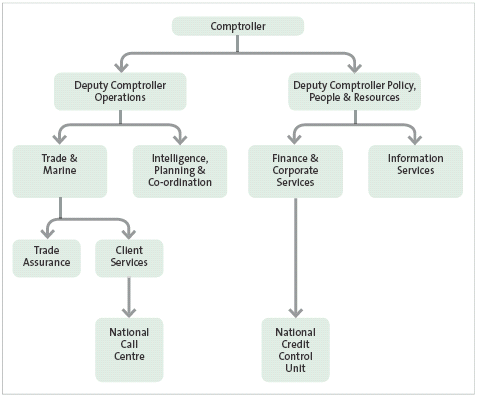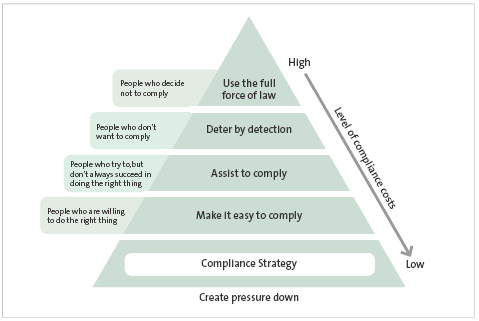Part 1: Introduction
1.1
The Auditor-General intends to regularly examine the activities of those public
sector entities that collect the most revenue. We chose to carry out a performance
audit of the New Zealand Customs Service: Te Mana Arai O Aotearoa (the Service)
because it was responsible for collecting about 15% of the total Crown revenue for
2006/07.
1.2
In this Part, we introduce the Service and explain:
- its role in collecting customs revenue;
- the voluntary compliance regime for collecting customs revenue;
- the scope of our audit; and
- how we carried out our audit.
New Zealand Customs Service
1.3
The Service has four areas of focus, which are border security, community
protection,1 trade and tourism support, and customs revenue collection. Our audit
focused on the Service’s role in collecting customs revenue.
1.4
Each year, the Service receives about $75 million in Crown funding. It also receives
about $35 million from third parties, including other government departments,
for services it provides on their behalf. The Service has about 1300 employees
throughout New Zealand and overseas (for example, in Beijing and Sydney).
1.5
In this report, we refer to the activities and responsibilities of particular
organisational units within the Service. Figure 1 shows their relationship to each
other and to the Comptroller of Customs (the Chief Executive of the Service).
Figure 1
The organisational units of the New Zealand Customs Service discussed in this
report

Note: For a fuller description of the Service’s organisational structure, refer to the Service’s website (www.customs.govt.nz).
Collecting revenue
1.6
The Service collects revenue from GST on imports, customs duties, and excise
(customs revenue). Customs revenue becomes due when the Service clears
imported goods and when excisable goods are moved from where they were
manufactured. When traders and individuals complete customs declarations
and manufacturers confirm that they have made or moved excisable goods, an
entry is generated in the Service’s electronic system to record import, export,
and excise transactions (CusMod). Information Services operates CusMod, which
was introduced in 1996 and checks the information entered and calculates the
customs revenue due. After data from CusMod is transferred into the Service’s
financial management information system (FMIS), the Service sends invoices to
the traders and collects the revenue due.
1.7
The Customs and Excise Act 1996 (the Act), the Goods and Services Tax Act 1985,
and the Tariff Act 1988 contain the main legislative requirements for customs
revenue.
1.8
The Estimate of Appropriations forecast that the Service would collect customs
revenue of $9,072 million in 2006/07. Figure 2 shows that GST on imports,
customs duties, and excise make up, respectively, about 62%, 20%, and 18% of this
total.
Figure 2
Forecast customs revenue for 2006/07
This figure shows the proportion of customs revenue forecast to be collected for GST on imports, customs duties, and excise.
| Proportion of forecast customs revenue | Forecast customs revenue ($ million) | |||
|---|---|---|---|---|
| GST on imports | 62% | $5,670 | ||
| Customs duties | Import duties on dutiable goods and excise-equivalent duties | 20% | $1,773 | |
| Excise | Petroleum fuel and petroleum fuel products | 58% | 18% | $1,629 |
| Alcohol and alcohol products | 33% | |||
| Tobacco and tobacco products | 9% | |||
| Total customs revenue | 100% | $9,072 | ||
Source: This figure has been compiled from the Service’s information. Figures are rounded.
Voluntary compliance regime for collecting revenue
1.9
The obligations for customs revenue are outlined in law and are backed up with
strong enforcement powers and penalties. The Service does not approach the task
of collecting this revenue with an “enforcement” mentality – its core strategy is
to support voluntary compliance. Voluntary compliance means that individuals
and businesses are responsible for enquiring about their compliance obligations,
voluntarily lodging entries with the Service, completely and accurately declaring
the required information, accurately calculating the customs revenue due, and
paying the amounts owing on the due date and in the required manner.
1.10
Voluntary compliance regimes usually offer incentives for complying and are
designed to try to make compliance easy. Those who choose not to comply face
increasingly severe interventions by the regulator to enforce compliance (see
Figure 3).
Figure 3
The compliance triangle
This figure shows that most people are willing to comply and know what to do to comply, while progressively fewer people need progressively stronger interventions to ensure that they comply.

Source: Adapted from the Service’s strategy for compliance.
The scope of our audit
1.11
Our audit examined whether the Service:
- had suitable arrangements to collect customs revenue;
- accurately received entries, and calculated and collected the customs revenue; and
- adequately reported on its revenue-collecting performance in its annual report.
1.12
We examined the Service’s arrangements for collecting customs revenue and
analysed in detail CusMod’s performance for collecting revenue against our
expectations.
1.13
We did not audit the Service’s arrangements for collecting revenue from other
sources, such as fees and selling seized goods. These activities generate a
comparatively small amount of revenue.
How we carried out our audit
1.14
To become familiar with the Service’s business, we visited the International Mail
Centre, inspection (including x-ray) facilities at Auckland airport and seaport, and
the Service’s offices in Auckland and Manukau cities.
1.15
We interviewed the Service’s staff in Auckland, Dunedin, and Wellington. We met
with selected representatives from industry groups, including customs brokers
and a company the Service contracted to deliver an electronically managed
messaging service. We reviewed many documents. We tested critical procedures
and repeated selected processes within CusMod and the FMIS.
1: The New Zealand Customs Service helps to protect communities by, for example, detecting and preventing the importation of illicit drugs, illegal weapons, and objectionable pornography.
page top
